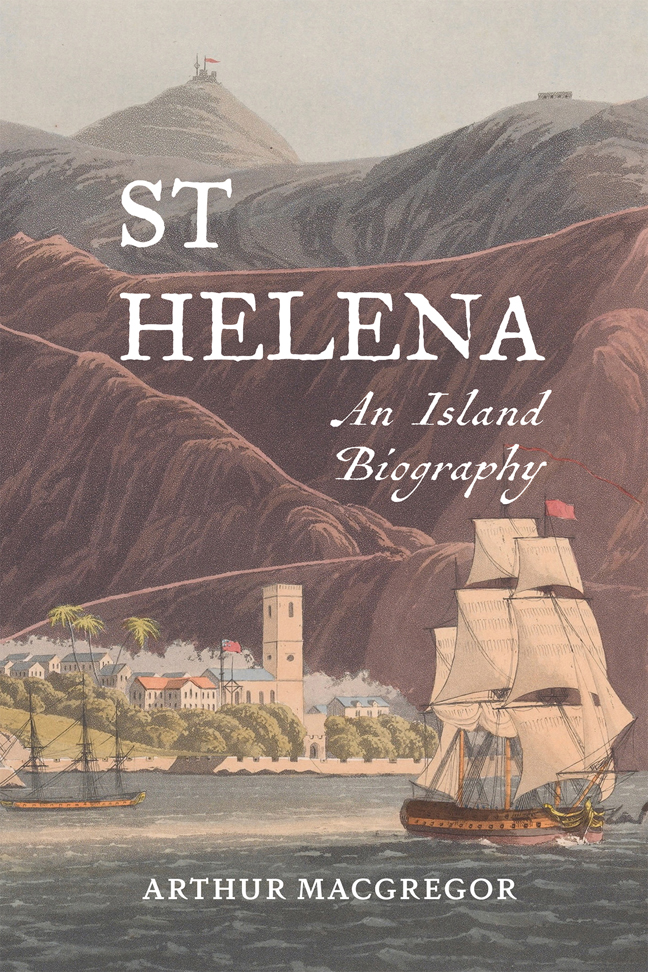Book contents
- Frontmatter
- Contents
- List of Illustrations
- Photo credits
- Preface
- Acknowledgements
- 1 Genesis
- 2 The breach: Europe and St Helena collide
- 3 Population and environment: early impacts
- 4 Population and environment: asserting control
- 5 ‘The citadel of the South Atlantic’
- 6 Scientists in transit: St Helena as a site for scientific investigation
- 7 Napoleon on St Helena
- 8 Later detainees, 1800s and 1900s
- 9 A place in the modern world
- Appendix: Governors of St Helena
- Bibliography
- Index
- Frontmatter
- Contents
- List of Illustrations
- Photo credits
- Preface
- Acknowledgements
- 1 Genesis
- 2 The breach: Europe and St Helena collide
- 3 Population and environment: early impacts
- 4 Population and environment: asserting control
- 5 ‘The citadel of the South Atlantic’
- 6 Scientists in transit: St Helena as a site for scientific investigation
- 7 Napoleon on St Helena
- 8 Later detainees, 1800s and 1900s
- 9 A place in the modern world
- Appendix: Governors of St Helena
- Bibliography
- Index
Summary
All commentators agree that the first encounter with St Helena is best conceived from sea-level: so many chapters in the island's history open from this dramatic – even intimidating – perspective. The effect is well captured in one of the earliest representations of the island, that of 1601 by the German cartographer and engraver Theodore de Bry (Figure 1): although de Bry's view (evidently compiled at second hand, for he never ventured across the Atlantic) lacks accuracy in terms of detailed topography, it succeeds in capturing something of the drama of the mariner's experience, enlarged upon by a much later map-maker, Captain Edmund Palmer, in the introduction to his Military Sketch of the island, compiled in 1850–52:
St Helena lies in the strength of the s.e. trade wind, and is usually sighted by ships at a distance of 20 leagues, rising like a huge fortress from the bosom of the ocean. It is surrounded by a wall of precipitous cliffs from 1000 to 1800 feet in height, intersected by chasms, serving as an outlet for the water-courses of the island, and terminating in small coves more or less exposed to the fury of the waves. There are no less than twenty-three of these openings around the coast; but landing is almost impracticable except on the north-western or leeward side, and at Prosperous and Sandy Bays to windward, and even then only in favourable weather …
Much reliance will be placed in the following chapters on similar personal impressions of the island by writers and artists (see also Plate 1). For the moment, these initial snapshots will serve to establish an image of its lowering bulk, erupting from the otherwise unbroken surface of the ocean, before something of its principal features are set out in more objective terms.
The island and its setting
The Mid-Atlantic Ridge, on which St Helena forms an outlier, runs (for the most part below sea-level) roughly from Jan Mayen Island in the north to the sub-Antarctic Bouvet Island. The ridge marks the junction of two diverging tectonic plates, pushed up from the ocean floor by the irregular escape of magma through the slowly expanding fissure, resulting at intervals in volcanoes that breach the ocean's surface. St Helena (like its nearest neighbours, Ascension Island and Tristan da Cunha) is one such volcanic island, formed some 14.5 million years ago but inert for the past 6 million years.
- Type
- Chapter
- Information
- St HelenaAn Island Biography, pp. 1 - 7Publisher: Boydell & BrewerPrint publication year: 2024



